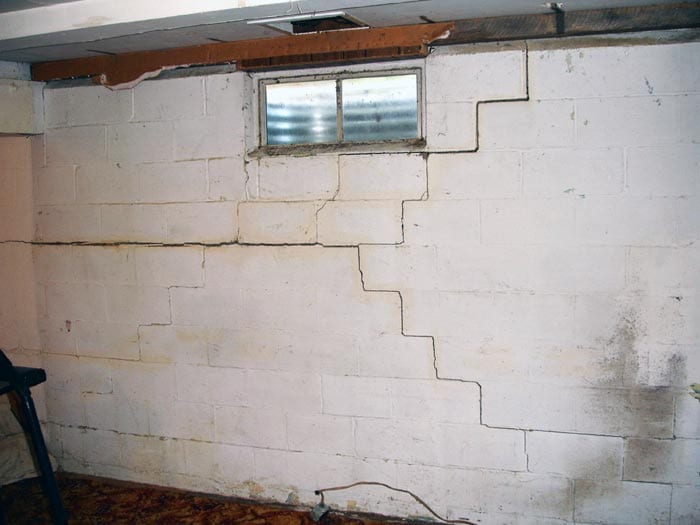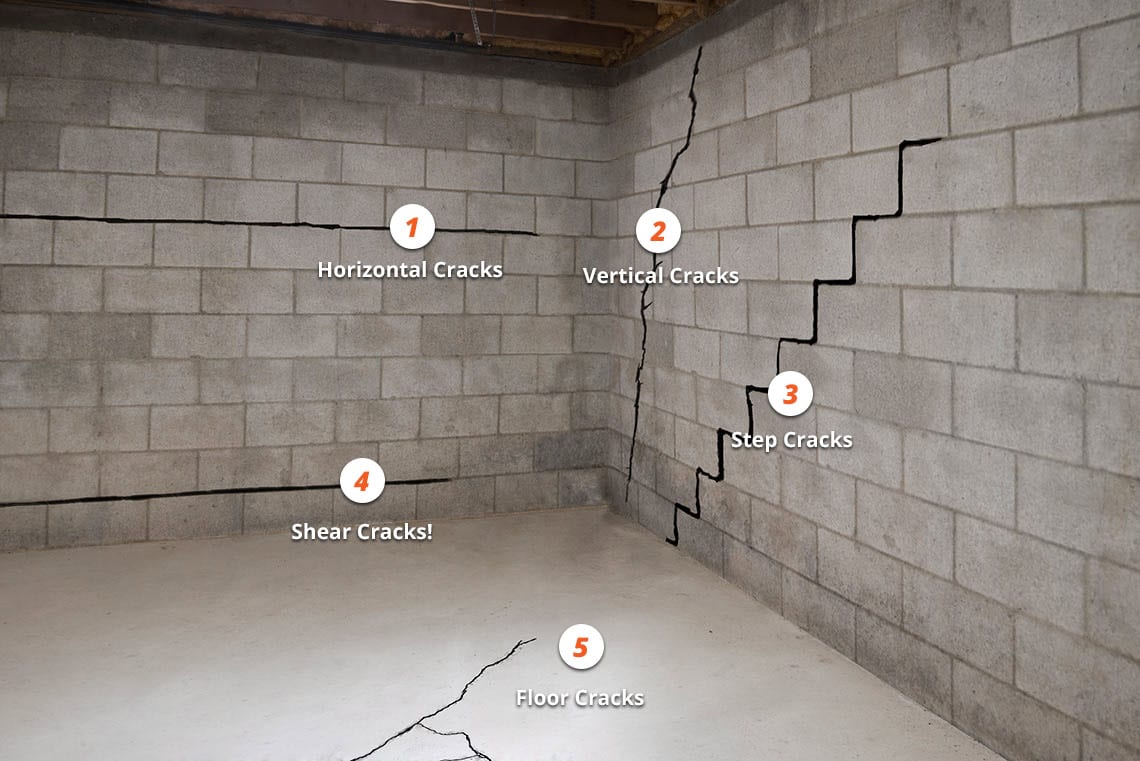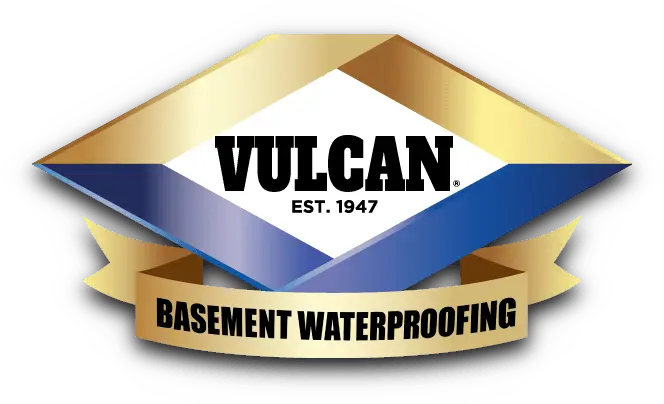Call for a Free Quote
- In Business since 1947 -
- Over 850,000 Basements Waterproofed -


Our Services:
Service Areas:
Crack Repair
In most cases basement foundation walls are fabricated from concrete. Cracks in basement walls are common and should be addressed before more serious issues occur. In some cases these cracks are the main entry point for water entering the basement. Cracks in Foundation walls develop for a variety reasons:
- Soil Erosion: This happens if the soil beneath the footing either washes away due to capillarity or a pipe leak and the footing (and basement wall on top of the footing) settles into the depression which can cause a vertical wall crack to develop.
- Hydrostatic Pressure: Water soaked soil exerts tremendous pressure over time on the foundation walls which can cause horizontal and/or vertical cracks.
- Shrinkage of Concrete or Mortar: These cracks are small and usually do not increase size or compromise the foundation. They are cosmetic imperfections in the walls.
- Construction Problems: substandard concrete, undersized footings and insufficient support beams are a few examples that can lead to cracks developing in foundation walls.
The Five Most Common Types of Basement Cracks

The most common problem associated with foundation wall cracks is water penetration. These cracks create openings into the basement that water can pass through, which makes foundation crack repair essential to keeping water out of the basement.
In most cases basement wall cracks are relatively easy and inexpensive to repair. However in some cases they are signs of serious structural issues developing and more involved and costly solutions are needed. There are many methods used today to try to correct foundation wall cracks. Many of these methods are ineffective and provide only temporary relief:
Caulk Crack Repair: This is a commonly used and simple method which plugs the crack with a caulk seal. This kind of fix is only skin deep- water will still fill the crack behind the patch. Efflorescence- a white, powdery mineral salt deposited by the water, breaks the caulk’s seal, while the pressure of the water makes the caulk peel off. This kind of repair will last one or two years.
Epoxy Crack Injections: Some Contractors or waterproofness use epoxy to seal a foundation wall crack. These seals are strong and rigid. However, epoxy must be applied to only a very dry surface, and because it’s very slow to cure, it may run out the other side of the wall crack before hardening.
Since epoxy plugs are rigid and inflexible, as the concrete wall expands and shrinks, this plug may fail. In some cases, it can even lead to a new crack forming near the existing crack due to the continued water pressure (hydrostatic pressure) behind the wall.
Fixing Wall Cracks from the Outside: Some waterproofing companies will recommend excavating the entire outside of the wall where the crack appeared and installing a waterproof barrier. To do this, landscaping, sidewalks, porches, patios, steps, gardens, and anything else outside of the foundation is removed, and mounds of dirt are piled on the lawn.
Once completed, the dirt and landscaping are returned. However, the fluffed, excavated soil will settle, and will never be compacted in as tightly as before excavation. As a result water will more easily flow through the fluffed soil (through capillary action) and pool near the foundation. The surface soil may need to be regraded after a year or so. This can be an effective but expensive way to fix a crack.
Urethane Sealing: A somewhat effective method is to seal the crack with urethane. As the urethane sets, it effectively walls off the crack without running out the other side. Unlike the more rigid options, urethane can flex slightly with wall movement, helping it have longer life as the basement walls expand and shrink. However, a 1/16th inch crack can expand to as much as 1/8th inch. In these cases, urethane will not be able to expand nearly enough to maintain the seal. Eventually, even this solution will fail, and the gap will begin to leak once more.
Polyurethane Polymer Sealing: One of the better methods for sealing a wall crack is to seal it with a high-viscosity polyurethane polymer. Unlike epoxy, some types of polyurethane can bond well to concrete even when it’s wet. The high viscosity of some polyurethane polymers allows it to fill even hairline cracks, creating a deep hold on the crack’s edges.
Unlike urethane, a polyurethane polymer is able to expand to up to 20 times its volume. And, unlike the costly exterior methods, the work does not require exterior excavation and can be completed in a few hours.
Even polyurethane polymer sealing, however, can experience a partial failure, and over time, these seals will also occasionally show a small leak.
Hydraulic Cement Fillings: Of the methods available today this is the one we believe is most effective for the majority of cracks. It involves chiseling an inverted V-groove in the wall 1” wide by 1” deep and filling the groove with a specially formulated commercial grade Xypex crystalline hydraulic cement. This crystalline is substantially different from traditional barrier products like membranes and cementitious coatings.
Basic to the development of Xypex Crystalline Technology was a thorough understanding of concrete’s chemical and physical makeup. Concrete is porous. Its tunnel-like capillaries are a natural part of its mass, and permit the passage of water and other liquids. Researchers at Xypex recognized the opportunity for a chemical treatment that would fill these capillaries to prevent the penetration of water and other liquids from any direction. By means of diffusion, the reactive chemicals in Xypex products use water as a migrating medium to enter and travel down the capillaries of the concrete.
This process precipitates a chemical reaction between Xypex, moisture and the by-products of cement hydration, forming a new non-soluble crystalline structure. This integral structure fills the capillary tracts rendering the concrete waterproof.
- Xypex creates a crystalline structure deep within the pores and capillary tracts of the concrete mass to prevent the penetration of water and aggressive chemicals. In contrast, barrier-type products function only at the surface of the concrete.
- Because Xypex is not dependent on surface adhesion to achieve its waterproofing effect, it is resistant to extreme hydrostatic pressure.
- It is not subject to the deterioration problems encountered by membranes.
- Xypex is permanent and reactivates whenever water is present.
Your Trusted Basement Waterproofers
Established 1947 Our Only Business for Over 65 Years
